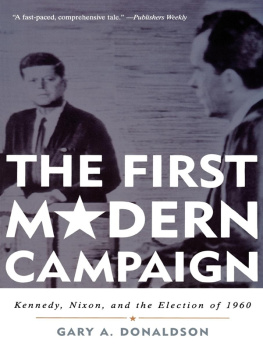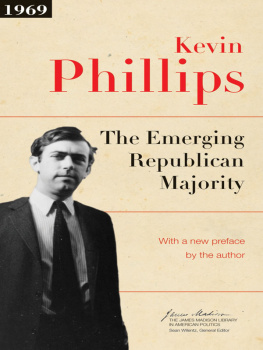When America Liked Ike
When America Liked Ike
How Moderates Won the 1952 Presidential Election and Reshaped American Politics
Gary A. Donaldson
ROWMAN & LITTLEFIELD
Lanham Boulder New York London
Published by Rowman & Littlefield
A wholly owned subsidiary of The Rowman & Littlefield Publishing Group, Inc.
4501 Forbes Boulevard, Suite 200, Lanham, Maryland 20706
www.rowman.com
Unit A, Whitacre Mews, 26-34 Stannary Street, London SE11 4AB
Copyright 2017 by Rowman & Littlefield
All rights reserved . No part of this book may be reproduced in any form or by any electronic or mechanical means, including information storage and retrieval systems, without written permission from the publisher, except by a reviewer who may quote passages in a review.
British Library Cataloguing in Publication Information Available
Library of Congress Cataloging-in-Publication Data
ISBN 978-1-4422-1175-9 (cloth : alk. paper)
ISBN 978-1-4422-1177-3 (electronic)
 The paper used in this publication meets the minimum requirements of American National Standard for Information SciencesPermanence of Paper for Printed Library Materials, ANSI/NISO Z39.48-1992.
The paper used in this publication meets the minimum requirements of American National Standard for Information SciencesPermanence of Paper for Printed Library Materials, ANSI/NISO Z39.48-1992.
Printed in the United States of America
Contents
| ACLU | American Civil Liberties Union |
| ADA | Americans for Democratic Action |
| AES | Adlai E. Stevenson |
| AESP | Adlai E. Stevenson Papers, Princeton University |
| COHC | Columbia [University] Oral History Collection |
| DDE | Dwight David Eisenhower |
| DNC | Democratic National Committee/Convention |
| ELOHC | Eisenhower Library Oral History Collection |
| EP | Eisenhower Papers, Eisenhower Library, Abilene, Kansas |
| FDR | Franklin Delano Roosevelt |
| HST | Harry S. Truman |
| HSTL | Harry S. Truman Library, Independence, Missouri |
| HSTLOHC | Harry S. Truman Library Oral History Collection |
| HSTP | Harry S. Truman Papers |
| LBJ | Lyndon Baines Johnson |
| LBJA | Lyndon Baines Johnson Archives |
| LBJL | Lyndon Baines Johnson Library, Austin, Texas |
| LBJLOHC | Lyndon Baines Johnson Library Oral History Collection |
| LBJOC | Lyndon Baines Johnson Oral History Collection |
| MHS | Massachusetts Historical Society, Boston |
| NYT | The New York Times |
| PPP | Public Papers of the Presidents |
| RMNL | Richard M. Nixon Library, Loma Linda, California |
| RMNP | Richard M. Nixon Papers |
| RNC | Republican National Committee/Convention |
| U.N. | United Nations |
| WSHS | Wisconsin State Historical Society, Madison, Wisconsin |
What makes the 1952 campaign so important? Why write a book about it? Celebrated journalist Jon Meacham, in 2015, wrote a book about the administration of President George H. W. Bush, where he concludes that the current conflicts between the Democrats and the Republicans in Washington had their beginnings in 1989. That year, Newt Gingrich, the newly elected minority whip, represented the Republican Right. He confronted Bushthe then newly elected president of the United States and leader of the Republican moderatessometimes called the Establishment Republicans. The two, Meacham insists, clashed over policy. To Meacham, that was the origins of the current conflicts between the Republican Right and their moderate brethren.
In this book, I will argue that that conflict had its origins much earlier, at least as far back as the 1952 presidential election. That year, Eisenhower, a moderate among moderates, ran as a Republican. Running against him for the Republican nomination was Robert A. Taft, the son of a president and an ardent conservative. The Taft wing of the party clashed head on (and even dramatically) against the Eisenhower moderates. Taft died soon after the election, but the Taft wing of the party lived on for decades, followed in the Senate by Barry Goldwater in the mid-1960s, and then by Ronald Reagan through the 1980s. That wing of the Republican Party (the right wing, the Old Guard, and the Tea Party) has been around for decades, always pushing against the Republican moderates, always fighting what they called the me-tooism of the Eisenhower-Dewey-Rockefeller wing of the party.
The 1952 campaign was not, as some have argued, a party realignment, but it was a sharp political diversion, even a departure from the nature of American politics. The 1952 presidential campaign was the first election following the New Deal-Fair Deal era of American economic history. It was the first election since 1928 in which an incumbent was not on the ticket. And it was the first election since 1932 in which Franklin Roosevelt (or his successor Harry Truman) did not run.
There was also a departure among the Democrats. Adlai Stevenson, the Democratic nominee, realized in 1952 that Truman, for several reasons, was not a popular figure, and that the wave of the future did not include the New Deal-Fair Deal philosophy of big government. Stevenson himself was not much of a Roosevelt New Dealer-type liberal. His response as the Democratic candidate in 1952 was to cut himself away from Truman, to get as far away from the Little Man from Missouri as possible. The Democratic Party then stopped being the party of the New Deal and the Fair Deal and started becoming something much more moderate, perhaps less liberal under Stevensons moderation. Lyndon Johnson may have tried to bring back to the Democratic Party that old New Deal-Fair Deal purpose in the 1960s, but the time for that type of economic divergence had probably passed. If you are looking for a time when the New Deal-Fair Deal era came to an end, look no further than 1952; and if you are looking for a figure, a person, who was responsible for that end, look no further than Adlai Stevenson.
The 1952 campaign was also the first election since World War II (or at least the first election since the debacle of 1948).That means that the depression and the war, the two defining moments of the twentieth century, were both behind America. And Americans could look forward for the first time in decades, with a new outlook.
It was also the first campaign in which television played a part. Television had been around in one form or another for several years, and by the 1960 presidential campaign, television would truly become the deciding factor, but in 1952 television made a difference at the Republican convention in Chicago, and for the first time a candidate would introduce to the American voter campaign films (some short, some long).
In 1952, really for the first time, we can see the power of middle-class voters, now in the process of moving from the inner cities out into the more conservative suburbs; organized labor, for the first time, became a significant voting bloc capable of swaying industrial regions of the nation; women became a significant antiwar bloc, who feared sending their sons and husbands into an insignificant war on the other side of the globe; white southerners began making their way slowly into the more conservative Republican Party; and African Americans, just as slowly, began turning their backs on the party of Lincoln.
The election of 1952 was a huge turning point in American political history. New groups were forming, new coalitions were forming, and a new attitude toward the world was beginning to take shape. The political world of today had its beginnings in 1952, an election that seemed to have little significance at the time, mostly because it was a landslide for Eisenhower and few people remember the Democratic nominee Adlai Stevenson. For most Americans, the pendulum had simple swung back, Ike was the obvious leader, and Stevenson (if at all he is remembered) was the candidate with the hole in his shoe. But the 1952 campaign was truly the beginning of modern American politics.
Next page





![T. H. Logwood - Voter Fraud and the 2020 Presidential Election; “Joe Biden wins by a Miraculous Landslide” [with appendices]](/uploads/posts/book/259666/thumbs/t-h-logwood-voter-fraud-and-the-2020.jpg)


 The paper used in this publication meets the minimum requirements of American National Standard for Information SciencesPermanence of Paper for Printed Library Materials, ANSI/NISO Z39.48-1992.
The paper used in this publication meets the minimum requirements of American National Standard for Information SciencesPermanence of Paper for Printed Library Materials, ANSI/NISO Z39.48-1992.